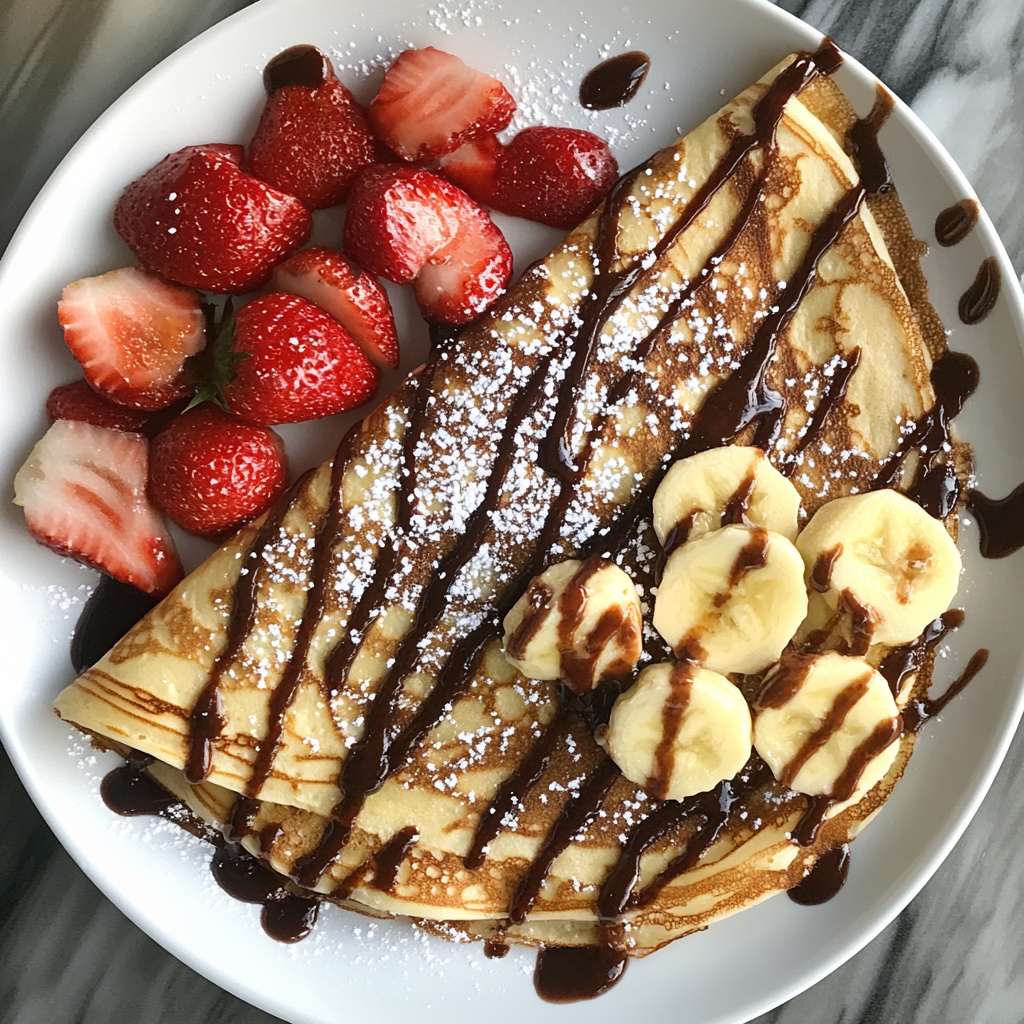Introduction:
Crepes are one of the most beloved dishes in French cuisine, and for good reason. Their versatility and delicate texture make them the perfect base for both sweet and savory fillings. Whether you prefer a simple sprinkling of sugar, a dollop of Nutella, or a savory combination of cheese and vegetables, crepes can easily be adapted to suit any flavor profile. But, at the heart of all great crepes is the classic French recipe—thin, tender, and slightly crispy around the edges.
Making crepes might seem intimidating at first, but with the right technique and a few simple ingredients, they come together quickly. This recipe for Classic French Crepes is straightforward and produces light, delicate crepes that are perfect for breakfast, brunch, or even dessert. With a combination of flour, eggs, milk, and a touch of butter, these crepes have the ideal balance of flavor and texture.
Once you’ve mastered the art of making crepes, the possibilities for fillings and toppings are endless. You can enjoy them as a sweet treat with lemon sugar, fresh fruit, or whipped cream, or opt for a savory version with ingredients like spinach, mushrooms, and cheese. Regardless of how you choose to fill your crepes, their thin, tender texture is sure to impress anyone you serve them to.
Ingredients:
For the crepes:
- 1 cup all-purpose flour
- 2 large eggs
- 1 1/2 cups milk (whole or 2% milk works best, but you can substitute with almond or oat milk for a dairy-free version)
- 2 tablespoons unsalted butter, melted (you can use vegetable oil as a substitute)
- 1/4 teaspoon salt
- 1 teaspoon vanilla extract (optional, for a touch of sweetness)
- 1 tablespoon granulated sugar (optional, for sweet crepes)
- Butter or oil for cooking (for greasing the pan)
For filling and toppings (optional, depending on your preference):
- Lemon wedges and sugar (for a classic, simple filling)
- Fresh fruit (berries, bananas, or apples) and whipped cream (for a sweet treat)
- Nutella, peanut butter, or almond butter (for a rich, creamy filling)
- Cheese and ham (for a savory option)
- Maple syrup or honey (for a sweet finish)
Instructions:
Step 1: Prepare the Batter
- Mix the Dry Ingredients: In a large mixing bowl, whisk together the flour, sugar (if using), and salt. The flour will form the base of your batter and give the crepes their structure.
- Add the Wet Ingredients: In a separate bowl, beat the eggs and add the milk, vanilla extract (if using), and melted butter. Whisk until the mixture is smooth and well combined. Adding melted butter to the wet ingredients helps make the crepes more tender.
- Combine the Wet and Dry Ingredients: Slowly pour the wet mixture into the bowl with the dry ingredients, whisking constantly to avoid lumps. The batter should be thin, with a consistency similar to heavy cream. If the batter seems too thick, add a little more milk, one tablespoon at a time, until it reaches the right consistency.
- Let the Batter Rest: Cover the batter with plastic wrap and let it rest for at least 30 minutes at room temperature. Resting the batter allows the flour to absorb the liquid fully, which will result in more tender crepes. If you’re in a rush, you can skip this step, but letting the batter rest will give you the best results.
Step 2: Cook the Crepes
- Prepare the Pan: Heat a non-stick skillet or crepe pan over medium heat. Once the pan is hot, lightly grease it with a little butter or oil. To avoid excess butter, use a paper towel to wipe off any extra oil, leaving only a thin layer on the pan.
- Pour the Batter into the Pan: Pour about 1/4 cup of the batter into the center of the hot pan. Quickly tilt the pan in all directions to spread the batter evenly across the bottom of the pan. You want to create a thin, even layer of batter that covers the surface.
- Cook the Crepe: Cook the crepe for 1-2 minutes, or until the edges begin to lift and the underside is golden brown. You can check the underside by gently lifting the edge of the crepe with a spatula. If it’s golden and lightly crisp, it’s time to flip.
- Flip the Crepe: Use a spatula to gently lift the crepe from the pan. Carefully flip the crepe over and cook for another 30 seconds to 1 minute on the other side, just until it’s lightly golden. The second side cooks faster, so keep an eye on it.
- Remove the Crepe: Once the crepe is cooked, carefully slide it off the pan and onto a plate. Repeat with the remaining batter, greasing the pan lightly between crepes if needed.
Step 3: Fill and Serve
- Serve the Crepes: You can serve the crepes as soon as they are cooked, or you can stack them and keep them warm by covering them with a clean kitchen towel. They should be soft and flexible.
- Fill the Crepes: If you’re making sweet crepes, add fillings like fresh fruit, whipped cream, Nutella, or a sprinkle of sugar and a squeeze of lemon juice. For savory crepes, try fillings such as ham, cheese, spinach, or mushrooms. You can even fold or roll the crepes to enclose the fillings.
- Garnish and Enjoy: Top the crepes with a dusting of powdered sugar, drizzle with maple syrup, or add a dollop of whipped cream. For a savory touch, garnish with fresh herbs or a side of salad.
Tips for Perfect Crepes:
- Use a Non-Stick Pan: The key to making perfect crepes is using a non-stick skillet or a crepe pan. A good non-stick surface will ensure that your crepes cook evenly and don’t stick to the pan.
- Keep the Batter Thin: Crepes should be thin and delicate, so make sure your batter is not too thick. If it is, add a little more milk to thin it out.
- Rest the Batter: While this step is optional, resting the batter for 30 minutes allows the gluten to relax and the flour to fully absorb the liquid. This will result in a smoother, more tender crepe.
- Don’t Overcook: Crepes cook quickly. The first side typically takes 1-2 minutes, while the second side only needs about 30 seconds. Don’t overcook them, or they’ll become crispy and lose their soft texture.
- Get the Right Pan Temperature: Make sure your pan is hot enough but not too hot. If it’s too hot, the batter will cook too quickly and form bubbles. If it’s too cool, the crepes won’t brown properly.
Variations and Fillings:
- Sweet Fillings:
- Nutella, banana, and whipped cream.
- Lemon juice and powdered sugar.
- Mixed berries with a dollop of Greek yogurt.
- Fresh strawberries and chocolate sauce.
- Savory Fillings:
- Ham and cheese.
- Spinach, feta cheese, and mushrooms.
- Smoked salmon, cream cheese, and dill.
- Sautéed vegetables with goat cheese.
Nutritional Benefits:
While crepes are typically enjoyed as a treat, they can also be a relatively healthy option when prepared with wholesome ingredients. Here are some of the benefits:
- Eggs: Eggs are a great source of high-quality protein, essential amino acids, and important vitamins like B12 and riboflavin.
- Milk: Milk provides calcium and vitamin D, which are important for bone health, along with protein and other nutrients.
- Whole Wheat Flour (Optional): If you prefer to make a more nutrient-dense crepe, you can substitute some or all of the all-purpose flour with whole wheat flour. This adds fiber, vitamins, and minerals.
Conclusion:
Classic French crepes are an elegant yet simple dish that can be enjoyed in countless ways. Whether you prefer them sweet or savory, the thin, delicate texture and rich flavor make them a perfect option for breakfast, brunch, or even dessert. By mastering the basic crepe recipe, you can create an array of fillings that suit any occasion. The next time you’re in the mood for a delicious and versatile meal, reach for this classic French crepe recipe, and enjoy the endless possibilities that come with it!

